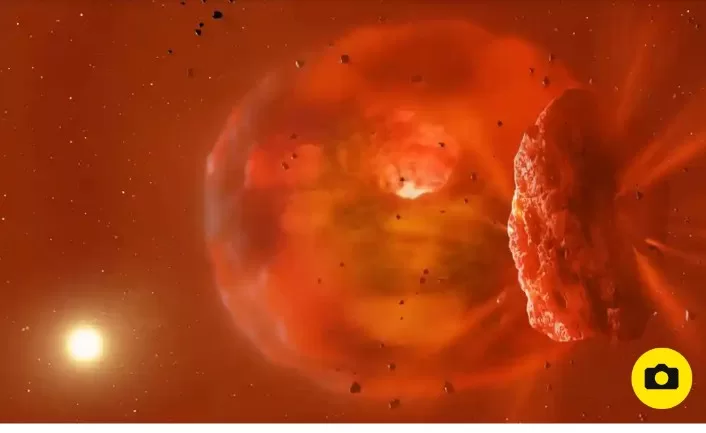In a groundbreaking observation, astronomers have captured the aftermath of a colossal collision between two massive planets, providing a rare glimpse into the cosmic spectacle resulting from this cosmic catastrophe. The celestial event is thought to have obliterated a pair of ice giant planets that violently collided, unleashing a shower of debris and forming a scorching, rapidly rotating object potentially hundreds of times the size of our Earth.
Dr. Matthew Kenworthy, a co-lead author of this extraordinary study conducted at the Leiden Observatory in the Netherlands, describes this cosmic drama as nothing short of spectacular. The energy generated by this planetary collision has transformed the remnant into a star-like entity. Although fainter than the primary star within its stellar system, this celestial entity is approximately seven times larger and is visible throughout the rest of the system.
The discovery arose from an unlikely source—a dedicated amateur astronomer who responded to a social media post by Dr. Kenworthy regarding a sun-like star known as ASASSN-21qj. The astronomer was initially searching for shadows cast by colossal planetary rings as they passed across the face of their parent star. The dimming of ASASSN-21qj in December 2021, though abrupt and enigmatic, piqued their curiosity.
Arttu Sainio, a volunteer citizen scientist for NASA, embarked on a quest to uncover the mystery behind the star’s inexplicable dimming. In his research, he delved into past observations of the star captured by NASA’s Neowise mission, an infrared space telescope. What he discovered was a sustained and steady brightening of infrared light from the same region approximately 900 days before the star’s mysterious dimming.
Dr. Kenworthy, reflecting on this fortuitous turn of events, remarked that the unexpected infrared brightening hinted at something extraordinary occurring near this distant star. This revelation set the astronomers on a fresh investigative path.
Through a meticulous analysis of the observations, the scientists concluded that the surge of infrared radiation stemmed from the formation of a blazing celestial object, referred to as a “synestia.” This synestia was created by the cataclysmic collision of two planets, both nearly as large as Neptune. The infrared data indicated that this colossal, swiftly rotating entity exhibited temperatures surpassing 700 degrees Celsius for approximately three years. Eventually, it will cool and coalesce into a new celestial body orbiting the star.
As detailed in the prestigious journal Nature, the star’s dimming commenced approximately 2.5 years after the synestia’s formation, as a colossal cloud of fine impact debris drifted across the star’s surface.
Simon Lock, another co-lead author at the University of Bristol, expressed the significance of this revelation, stating that it marks the first instance of observing the afterglow produced by such a planetary collision. While astronomers have previously detected debris and planetary discs, witnessing the afterglow of the celestial body created by this cosmic clash is unprecedented.
Astronomers are now eager to continue their observations to confirm their hypotheses. If the dust cloud continues to encircle the star, it is anticipated that in five to ten years, it will shift to one side of the star’s path, allowing astronomers to observe the star’s light reflecting off the dust with the aid of the most advanced ground-based telescopes. Furthermore, the James Webb Space Telescope may be instrumental in detecting the infrared radiation emanating from the celestial dust and the newly formed planet resulting from this monumental planetary collision.
This groundbreaking discovery opens a window into the captivating and dynamic world of celestial collisions, offering a glimpse of the extraordinary forces shaping our universe.





